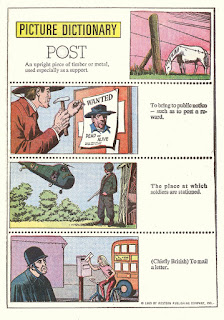Translate
Sunday, March 12, 2017
Pappy’s Sunday Supplement #8: Dan Spiegle and the land beneath the sea
Comic artist Dan Spiegle died on January 28, 2017, at age 96. He had begun his career by drawing the newspaper comic strip, Hopalong Cassidy, and when that ended in the mid-fifties he went to work for Western Publishing, doing comic books under the Dell and later Gold Key colophons. When Western closed its comics line Spiegle went on, working a lot with writer/creator Mark Evanier. Spiegle was a true professional, whose work is seen in many of Dell’s titles licensed from TV, especially Westerns.
You can read an interview done with Spiegle in 1972, from Graphic Story Magazine. See the link below.
Captain Venture only appeared in two issues in the sixties. The feature was a back-up for Spiegle’s Lost in Space. I showed issue number 1 in 2013, and I also have a link for that below. Unlike the first issue, which was made up of reprints from Lost in Space, the second issue is an original story. It borrows a bit from H.G. Wells’ The Island of Dr Moreau. I say if you are going to swipe plots or story ideas, swipe from the best.
From Captain Venture and the Land Beneath the Sea #2 (1969). Written by Gaylord Dubois.
Graphic Story World interview with Dan Spiegle
Here is the first issue of Captain Venture. Just click on the thumbnail.
Subscribe to:
Post Comments (Atom)







































4 comments:
Just yester-day, I was reading of Prototaxites, large organisms of which now only fossils are found, believed to have been giant fungi.
The story gets wrong the gravitational physics of hollow planets. If a planet were somehow a hollow ball, whose shell were of uniform thickness and composition, then the center of gravitation would still be the center of the ball, not any one point half-way through the shell nor the set of all such points (which themselves would be a sphere); but at every point within the shell the effect of gravitational forces on things would cancel-out. (But understand that the opposing sides of the shell would be pulling at each other, as well as at whatever were within the shell; large hollows in massive bodies are not typically sustainable.)
If the center of gravity were somehow half-way through the shell, and someone or something had fallen within the shell, then the attraction would be back to that center. Upon having their initial momentum checked or spent, Rex and Scotty would then have fallen back towards that center.
My initial reaction to Rex and Scotty siding with Hera in her fight was to note how often speculative fiction used to presume that, in a fight about which one knew almost nothing, the alien creature who looked most like H. sapiens sapiens were the Good Guy (or Good Gal). In that context, it was interesting to have Hera be revealed to be a villainess. It would have been still better had Rex and Scotty expressed a reälization that the creatures who had downed her craft might have been working to some laudable end.
Of course, the whole business of confusing scientific advancement with the creätion of Flub-a-Dubs is another matter.
Careful, Daniel...you are treading on beliefs of a hollow Earth, which some imaginative folks think house the flying saucers, not to mention Deros and other unpleasant creatures.
Oh yeah...and then there is Pellucidar, but Edgar Rice Burroughs never pretended his novels were real (I think).
Not only do humans assume other lifeforms that look like us are good, we are suckers for pretty faces.
Did Spiegle do the Mini-Comics and Chuckle-Times?
E., no, although I don't know who did.
Post a Comment